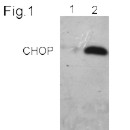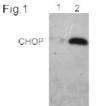Product Details
| Alternative Name: | C/EBP homology protein, Growth arrest and DNA damage inducible protein 153, GADD153 |
| |
| Clone: | 9C8 |
| |
| Host: | Mouse |
| |
| Isotype: | IgG2b |
| |
| Immunogen: | Recombinant mouse CHOP (C/EBP homology protein). |
| |
| UniProt ID: | P35639 |
| |
| Species reactivity: | Human, Mouse
|
| |
| Specificity: | Recognizes an N-terminal epitope. |
| |
| Applications: | ICC, IP, WB
|
| |
| Recommended Dilutions/Conditions: | Western Blot (1µg/ml)
Suggested dilutions/conditions may not be available for all applications.
Optimal conditions must be determined individually for each application. |
| |
| Application Notes: | Detects a band of ~31kDa by Western blot. |
| |
| Formulation: | Liquid. In PBS containing 1mg/ml BSA and 0.05% sodium azide. |
| |
| Handling: | Avoid freeze/thaw cycles. |
| |
| Shipping: | Blue Ice |
| |
| Long Term Storage: | -20°C |
| |
| Scientific Background: | CHOP is a small nuclear protein that is capable of dimerizing with transcription factors C/EBP α and β. Once dimerized, this complex inhibits the normal binding and function of C/EBP to classical binding sites. Inversely, the C/EBP-CHOP dimer gains binding activity to other non-classical C/EBP stress related targets.
Under normal cellular conditions this protein is not expressed in detectable levels, but is highly unregulated during times of cellular/ER stress. Examples of CHOP inducing stress include: treatment with tunicamycin, nutrient starvation and reducing agents that interfere with the calcium flux across the ER membrane. |
| |
| Regulatory Status: | RUO - Research Use Only |
| |

Figure: Western blot of endogenous CHOP from primary human fibroblasts using 9C8 (Prod. No.
ALX-804-551). Lane 1: Untreated cells. Lane 2: Cells treated with tunicamycin for 10 hours."
Please mouse over
Product Literature References
Cadmium induces Wnt signaling to upregulate proliferation and survival genes in sub-confluent kidney proximal tubule cells: P.K. Chakraborty, et al.; Mol Cancer
9, 102 (2010),
Abstract;
Maximal killing of lymphoma cells by DNA damage-inducing therapy requires not only the p53 targets Puma and Noxa, but also Bim: L. Happo, et al.; Blood
116, 5256 (2010),
Abstract;
Regulated increase in folding capacity prevents unfolded protein stress in the ER: C. Christis, et al.; J. Cell. Sci.
123, 787 (2010),
Abstract;
Comparative proteomics profiling of a phospholamban mutant mouse model of dilated cardiomyopathy reveals progressive intracellular stress responses: A.O. Gramolini, et al.; Mol. Cell Proteomics
7, 519 (2008),
Abstract;
CHOP-Dependent stress-inducible expression of a novel form of carbonic anhydrase VI: J. Sok, et al.; Mol. Cell. Biol.
19, 495 (1999),
Abstract;
Full Text
Induction of a secreted protein by the myxoid liposarcoma oncogene: M. Kuroda, et al.; PNAS
96, 5025 (1999),
Abstract;
Full Text
Cloning of mammalian Ire1 reveals diversity in the ER stress responses: X.Z. Wang, et al.; EMBO J.
17, 5708 (1998),
Abstract;
Full Text
Identification of novel stress-induced genes downstream of chop: X.Z. Wang, et al.; EMBO J.
17, 3619 (1998),
Abstract;
Full Text
Regulation of the pro-B-cell-specific enhancer of the Id1 gene involves the C/EBP family of proteins: S. Saisanit and X.H. Sun; Mol. Cell. Biol.
17, 844 (1997),
Abstract;
Full Text
Signals from the stressed endoplasmic reticulum induce C/EBP-homologous protein (CHOP/GADD153): X.Z. Wang, et al.; Mol. Cell. Biol.
16, 4273 (1996),
Abstract;
Full Text
Inhibition of adipogenesis by the stress-induced protein CHOP (Gadd153): N. Batchvarova, et al.; EMBO J.
14, 4654 (1995),
Abstract;












